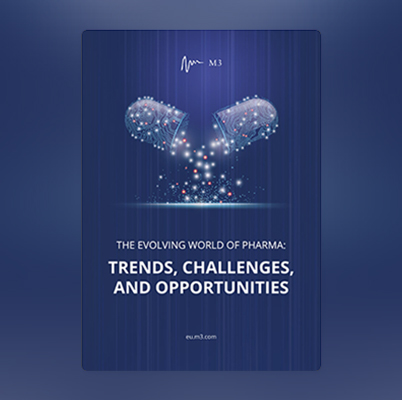In an era where artificial intelligence (AI) and predictive analytics promise unprecedented precision in customer engagement, pharma marketing finds itself at a paradoxical crossroads.
Despite pharma marketing undergoing rapid reinvention driven by AI tools designed to unify insight and streamline campaigns, a recent study by M3 found that 90% of pharma marketers report having at least 12 areas of responsibility competing budget areas – each demanding its own slice of attention, data and resources. This fragmented approach makes executing a truly data-driven, effective omnichannel strategy not just difficult but nearly impossible.
Omnichannel demands and an abundance of AI tools are creating bottlenecks in pharma marketing, as teams struggle to keep up with demands to deliver more, centralise insight and streamline reporting. So how can pharma marketers cut through the noise to create campaigns that deliver meaningful engagement that encourages growth and success?
From Promise to Pressure
The industry has long positioned AI as the key to smarter targeting, more relevant content and real time optimisation. However, it is clear that technology alone isn’t completely solving the problem. The rush to use AI tools has led to applications that don’t harness the full potential of AI and fail to successfully integrate them into the personalised process of marketing teams. Instead, it has exposed a data bottleneck.
Pharma marketers are now expected to deliver more tailored, timely content faster, across more channels and under stricter regulatory scrutiny. According to M3’s findings, over 50% of marketers require new marketing materials every two months or less, creating relentless demand for compliant, brand-consistent content at scale. Meanwhile, 50% cite tone and style consistency as their top content production challenge, highlighting the difficulty of maintaining quality amid high volume.
Extra pressure is added by the need to maximise content’s effectiveness. Pharma marketers are expected to deliver content that is not only scalable but also bespoke to their audiences. Ensuring consistency in tone and style while adapting content for local markets or translating across regions can also prove challenging.
Managing these competing demands while also finding ways to deliver high-quality, engaging content without compromising on brand voice and identity or exhausting limited resources is piling the pressure onto pharma marketers.
Fragmented Data, Fractured Strategy
With data siloed across brands, business units, channels and agencies, marketers often lack a single source of truth and suffer from data fragmentation. CRM insights, patient behaviour data, content performance metrics andHCP engagement stats all live in different systems with no cohesion or data flow between them. Connecting the dots between them requires more time and effort than most teams can spare.
Even when data is available, it’s not always readily actionable. With multiple stakeholders and platforms generating content simultaneously, marketing teams are wading through a torrent of creative assets, touchpoints and messages. Instead of enabling smarter targeting, this overload often results in redundant outreach, inconsistent messaging, and ultimately disengaged audiences.
The Illusion of Omnichannel
The concept of omnichannel marketing, where customer experiences are spread across all touchpoints, has become the norm in marketing activities. However, many pharma campaigns still operate in multichannel silos, where different platforms function independently rather than in synergy with each other.
Working across different channels brings several strategic hiccups that stifle marketing success. Different channels bring disparate KPIs,metrics and fragmented ownership that slows down processes and creates extra hurdles to overcome. Also, marketers can struggle with legacy technology that is deeply rooted within the processes but is actually slowly down or hindering growth. All of this makes unified execution an uphill battle and creates confusion amongst marketing teams – half of marketers report that channel overload is a significant obstacle in achieving seamless customer experiences.
What’s more, despite widespread access to data, many marketers are still struggling to harness it effectively. While 80% of pharma marketers rely on market research regularly, M3’s study notes growing gaps in in-house research capabilities. These gaps are particularly prevalent in designing compliant studies and distilling insights that can drive action. Without the right skills, the sheer volume of data becomes a liability instead of a strategic asset.
Furthermore, the culture of marketing teams is seeing an increasing pressure to prove ROI, but measuring performance across disconnected data sources and shortcomings in research capabilities is leading to an analytical maze. With so many variables in play, determining what’s working, and what isn’t, can take weeks, stunting growth and energy in revitalising campaigns.
AI Shifts the Burden – But Does it Remove it?
AI and machine learning should be pharma marketers’ best allies. With the right applications, repetitive tasks can be automated, insights can be uncovered at scale and predictive decision-making can be enabled. But the rise of AI is also shifting responsibility in unexpected ways. Rather than remaining the domain of dedicated data or analytics teams, AI insights are now landing squarely on marketers’ desks.
This democratisation of data is both empowering but also overwhelming. The burden of data interpretation is not removed but rather shifted from specialists to generalist marketers. While marketing teams gain more direct access to tools like predictive segmentation, content recommendation engines and performance dashboards, they are also expected to interpret and act on this information accordingly and quickly, without deep technical training.
Pressure mounts: it is no longer enough to generate data, marketers must be able to translate it – into decisions, into creative assets, and into action. On top of this, in pharma marketing, this translation also has to meet compliance standards, raising the bar further.
All of this results in a bottleneck. As the volume of available insights grows, so too does the pressure to absorb it, connect it, and make decisions in real time.
Breaking the Bottleneck
To unlock the potential of AI and omnichannel engagement, pharma marketers need to move away from a volume-based mindset of more campaigns, more channels, more assets. Instead they need to be focused on value and relevance.
Marketing teams need to centralise insight into a unified, accessible view for easier absorption and understanding. They can build or adopt specific platforms that unify the disparate data sources into a dashboard that offer a real-time, 360° view of performance and engagement.
Moreover, pharma marketers need to foster collaboration and cohesion that brings streamlined processes and practices to the forefront of marketing activities. Reporting can be streamlined via automated performance tracking tools that do the heavy lifting for marketing teams. Standardising KPIs across departments also supports faster decision-making and cohesive understanding across teams that prevents disjointed optics that slow down progress.
Content governance can be simplified by teams adopting modular content models and clear style frameworks. This allows content production to be scaled across teams while also maintaining consistency and compliance.
Reevaluating the quality of engagement can also break through this bottleneck. Prioritising quality can bring greater success instead of teams crossing their fingers for vast amounts of quality to maybe hit well. Measuring success not just by clicks or opens, but by real HCP or patient behaviour change that translates to ROI gives greater insight into teams marketing success and conversion. Retention, prescription lift and adherence are all areas to keep a keen eye on for success markers.
To break the stilted AI adoption, teams need to invest in capability building. Confidence in the technology that marketers use will quicken processes and bring greater insights that marketers fully believe and understand. Upskilling marketers to work with AI and analytics tools bridges the gap between data and strategy.
Perhaps most importantly, it means fostering closer collaboration between marketing, data science, medical affairs and commercial operations. As AI continues to evolve, its effectiveness will depend not just on the sophistication of the algorithms, but on the clarity of the strategy guiding them.
As over half of respondents in M3’s survey say research-backed decisions are a requirement, not a luxury, it’s clear that the days of intuition-led marketing are over. But for AI to fulfill its promise, organisations must support marketers with the training, partnerships and systems they need to succeed.
Conclusion: From Overload to Orchestration
Pharma marketing is navigating a perfect storm. From shrinking budgets and rising expectations to accelerating complexity and bottlenecked processes, marketing teams are struggling to keep up with omnichannel demands and AI applications.
Whether you’re building omnichannel strategies, managing compliance reviews, or scaling content production across markets, pharma marketers need more than just tools – they need trusted partners.
The solution isn’t in chasing more channels or newer tech. It’s in orchestrating the pieces already in play: aligning strategy, simplifying operations and focusing on what matters most – delivering meaningful engagement, not just more of it.
If marketers can rise to the challenge and centralise insight, simplify execution and focus on value, they’ll not only overcome the data bottleneck but redefine what effective engagement looks like in the AI era.



